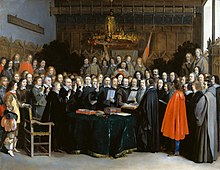Peace of Munster

The Peace of Munster ( Dutch Vrede van Munster , Spanish Tratado de Muñiste ) ended the Eighty Years War between Spain and the Republic of the Seven United Netherlands .
The peace negotiations took place from 1646 to 1648 as part of the Westphalian Peace Congress in Münster .
negotiations
The Spanish king was represented by the Count of Peñaranda . On the part of the United Netherlands, Holland was represented by two envoys (one of whom was Godart van Reede ), the other six provinces of Zeeland , Groningen , Utrecht , Friesland , Gelderland and Overijssel each by an envoy. The negotiations took place in the quarters of the ambassadors involved.
With the conclusion of the contract, the previous community of interests between the Netherlands and France, directed against Spain, ended. For peace between France and Spain , there was the 1659th
On January 30, 1648, the Spanish-Dutch contract was finally signed in the Krameramtshaus, the quarter of the Dutch and today's House of the Netherlands . On May 15, 1648, this contract was invoked in a solemn ceremony in the historic town hall of Münster .
In the Peace of Munster, the United Netherlands was recognized as a sovereign state. With that they also left the Holy Roman Empire .
Web links
- Contract text Latin-German (Internet portal "Westphalian History")